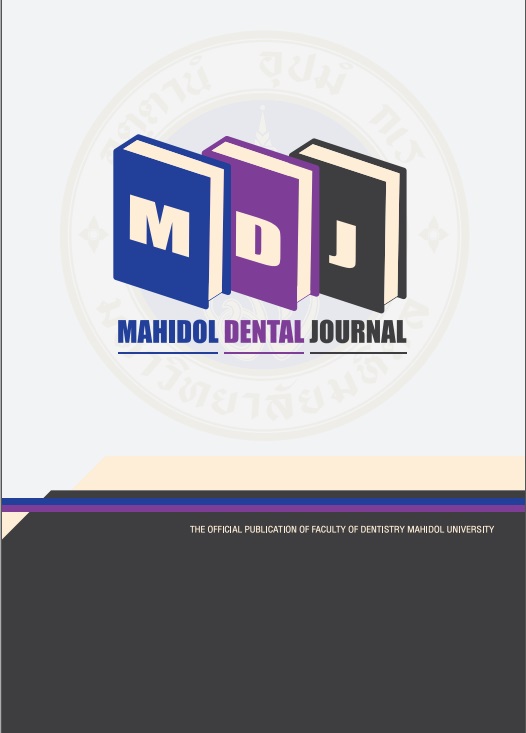Prevalence of lingual canals and their foramina in a group of Thai people using cone-beam computed tomography
Main Article Content
Abstract
Objective: Lingual canals and their foramina are one of the concerned structures that should be carefully evaluated prior to the procedure of implant placement. This retrospective study aimed to determine their prevalence in a group of Thai people and their characteristics by using cone-beam computed tomography (CBCT).
Materials and Methods: A total of 240 patients who had received CBCT in the mandible at the Faculty of Dentistry, Mahidol University, from January 2012 to July 2021 were studied. Lingual canals and their foramina were classified by their location into two groups. The foramen located in the center of symphysis is the median lingual foramen (MLF), which its canal called the median lingual canal (MLC). The other located laterally from the midline is the lateral lingual foramen (LLF), which its canal called the lateral lingual canal (LLC). The number, location, and distance related to the alveolar crest of MLF and LLF were recorded. The courses of MLC and LLC were also analyzed. A Chi-square test was used to compare the prevalence between groups.
Results: The study showed that each patient had at least one lingual canal and its foramen. The prevalence was 100% in MLC&MLF and 91.7% in LLC&LLF. The location of MLF was commonly superior position followed by inferior position. The course of MLC was commonly anteroinferior, anterosuperior, and horizontal, respectively. The LLF was most common in the premolar areas and its LLC course was usually anterior direction. The overall mean distance from the top border of lingual foramina to the highest point of the alveolar crest was 23.64±5.17 mm.
Conclusion: This study revealed that LLC and LLF are common anatomical structures that could be detected from CBCT. As far as mandibular implant placement procedure is concerned, operators should bear in mind LLC&LLF in the premolar areas.
Article Details

This work is licensed under a Creative Commons Attribution-NonCommercial-NoDerivatives 4.0 International License.
References
Peñarrocha-Diago M, Balaguer-Martí JC, Peñarrocha-Oltra D, Bagán J, Peñarrocha-Diago M, Flanagan D. Floor of mouth hemorrhage subsequent to dental implant placement in the anterior mandible. Clin Cosmet Investig Dent 2019; 11: 235-242.
Kusum CK, Mody PV, Indrajeet, Nooji D, Rao SK, Wankhade BG. Interforaminal hemorrhage during anterior mandibular implant placement. Dent Res J 2015; 12: 291-300.
Tostunov L. Implant zones of the jaws: implant location and related success rate J Oral Implantol 2007; 33: 211-220.
Laboda G. Life-threatening hemorrhage after placement of an endosseous implant: report of case. J Am Dent Assoc 1990; 121: 599-600.
Dubois L, de Lange J, Bass E, Van Ingen J. Excessive bleeding in the floor of the mouth after endosseous implant placement: a report of two cases. Int J Oral Maxillofac Surg 2010; 39: 412-15.
Tomljenovic B, Herrmann S, Filippi A, Kühl S. Life-threatening hemorrhage associated with dental implant surgery: a review of the literature. Clin Oral Implants Res 2016; 27: 1079-84.
Kim DH, Kim MY, Kim CH. Distribution of the lingual foramina in mandibular cortical bone in Koreans. J Korean Assoc Oral Maxillofac Surg 2013; 39: 263-8.
He P, Truong MK, Adeeb N, Tubbs RS, Iwanaga J. Clinical anatomy and surgical significance of the lingual foramina and their canals. Clin Anat 2017; 30: 194-204.
Tagaya A, Matsuda Y, Nakajima K, Seki K, Okano T. Assessment of the blood supply to the lingual surface of the mandible for reduction of bleeding during implant surgery. Clin Oral Implants Res 2009; 20: 351-5.
Baldissera EZ, Silveira HD. Radiographic evaluation of the relationship between the projection of genial tubercles and the lingual foramen. Dentomaxillofac Radiol 2002; 31: 368-72.
Bernardi S, Bianchi S, Continenza MA, Macchoarelli G. Frequency and anatomical features of the mandibular lingual foramina: systematic review and meta-analysis. Surg Radiol Anat 2017; 39: 1349-57.
Sherrard JF, Rossouw PE, Benson BW, Carrillo R, Buschang PH. Accuracy and reliability of tooth and root lengths measured on cone-beam computed tomographs. Am J Orthod Dentofacial Orthop 2010; 137 (Suppl): S100-8.
Katakami K, Mishima A, Kuribayashi A, Shimoda S, Hamada Y, Kobayashi K. Anatomical characteristics of the mandibular lingual foramina observed on limited cone-beam CT images. Clin Oral Implants Res 2009; 20: 386-390.
Tepper G, Hofschneider UB, Gahleitner A, Ulm C. Computed Tomographic Diagnosis and Localization of Bone Canals in the Mandibular Interforaminal Region for Prevention of Bleeding Complications During Implant Surgery. Int J Oral Maillofac Implants 2001; 16: 68-72.
Von Arx T, Matter D, Buser D, Bornstein MM. Evaluation of Location and Dimensions of Lingual Foramina Using Limited Cone-Beam Computed Tomography. J Oral Maxillofac Surg 2011; 69: 2277-85.
Lee GS, Kim JS, Seo YS, Kim JD. Effective dose from direct and indirect digital panoramic units. Imaging Sci Dent 2013; 43: 77-84.
Ludlow JB, Timothy R, Walker C, Hunter R, Benavides E, Samuelson DB, et al. Effective dose of dental CBCT-a meta analysis of published data and additional data for nine CBCT units. Dentomaxillofac Radiol 2015; 44: 20140197.
Yildirim YD, Güncü GN, Galindo-Moreno P, Velasco-Torres M, Juodzbalys G, Kubilius M, et al. Evaluation of mandibular lingual foramina related to dental implant treatment with computerized tomography: A multicenter clinical study. Implant Dent 2014; 23: 57-63.
Xie L, Li T, Chen J, Yin D, Wang W, Xie Z. Cone-beam CT assessment of implant-related anatomy landmarks of the anterior mandible in a Chinese population. Surg Radiol Anat 2019; 41: 927-34.
Soto R, Concha G, Pardo S, Caceres F. Determination of presence and morphometry of lingual foramina and canals in Chilean mandibles using cone-beam CT images. Surg Radiol Anat 2018; 40: 1405-10.
Sekerci AE, Sisman Y, Payveren MA. Evaluation of location and dimensions of mandibular lingual foramina using cone-beam computed tomography. Surg Radiol Anat 2014; 36: 857-64.
Jarraya M, Hayashi D, Roemer FW, Crema MD, Diaz L, Conlin J, et al. Radiographically occult and subtle fractures: A pictorial review. Radiol Res Pract 2013; 2013: 370169.


